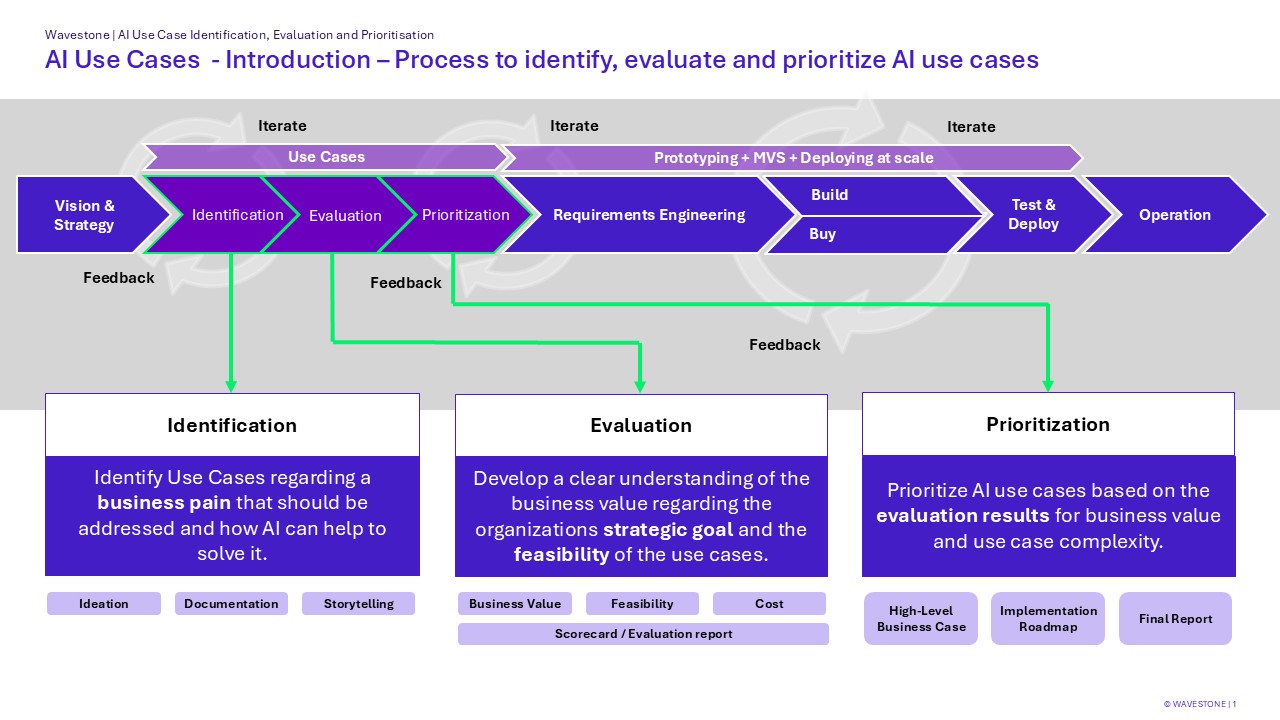What AI use cases must be prioritized to drive clear and significant ROI?
Published November 21, 2025
- Data & AI

Key takeaways
- AI use cases aligned with strategic priorities deliver lasting impact by solving real business challenges rather than isolated tech experiments
- High-ROI initiatives balance business value and manageable cost, creating measurable and repeatable outcomes
- Strong data foundations, mature infrastructure, and clear governance are prerequisites for scaling AI safely
As AI adoption matures across industries, the pressure is mounting for leaders to move beyond AI experimentation and to deliver real, scalable returns. However, due to poor use case selection and weak alignment to strategic goals, many stall at the pilot stage.
The way forward is to prioritize AI initiatives that combine strong business value, practical feasibility, and manageable cost – the sweet spot for fast, measurable returns.
Based on Wavestone’s AI Use Case Identification, Evaluation and Prioritization framework, leaders can confidently focus their AI investments.
How to prioritize AI use cases for ROI
1. Start with strategic alignment
Before pursuing any use case, ensure it ties directly to one or more of the organization’s strategic goals – whether that’s cost reduction, revenue growth, customer experience, or operational resilience. Strategic alignment gives initiatives staying power beyond the proof-of-concept phase and helps secure executive sponsorship.
High-ROI use cases typically:
- Tackle a known business pain point (e.g. onboarding friction, manual reporting)
- Align with high-priority business objectives (e.g. expanding into new markets, improving compliance)

Process to identify, evaluate and prioritize AI use cases
2. Target use cases with tangible economic value
Focus on applications that drive measurable impact, such as:
- Increased productivity: Automate repetitive, rule-based tasks in client servicing, finance, and operations. For example, AI agents that auto-populate onboarding forms or CRM entries reduce manual workloads and error rates.
- Enhanced decision-making: Use AI to consolidate client and product data for easier retrieval, saving hours of information gathering per week.
- Customer engagement uplift: Hyper-personalised marketing campaigns, built using AI-curated content, increase click-through rates and conversion.
Leaders should insist on business cases with specific metrics – like cycle time reduction, error rate improvements, or conversion uplift – rather than vague innovation goals.
3. Prioritize feasibility and readiness
High-value use cases are irrelevant if they’re not technically feasible. Leaders should work with tech teams to assess:
- Data availability and quality: Do you have the right structured and unstructured data sources? Are they integrated and governed?
- Tech stack readiness: Is your infrastructure mature enough to support GenAI, orchestration, and real-time AI monitoring?
- Talent and resources: Can the organization support development, deployment, and change management with current skillsets?
Use a structured scorecard to weigh feasibility alongside impact and cost. Flag any data remediation or capability gaps that may delay returns.
4. Leverage reusability and scale
Use cases that can be reused or scaled across teams, geographies, or products offer compounding returns. Examples include:
- Digital Sales Rooms for financial services firms – offering personalized client microsites, embedded chat, and document workflows
- GenAI-powered content engines that can be reused across multiple business units for comms, sales, and marketing
- AI-powered knowledge search that retrieves insights across documents, systems, and notes, useful for both sales and support teams
These use cases often begin in one function but, with shared platforms and modular architecture, can expand quickly.
5. Don’t underestimate governance & compliance fit
Some of the most attractive use cases become unviable when risk, legal, or compliance teams raise red flags. Prioritize those where:
- Human-in-the-loop review is possible
- Data privacy, bias mitigation, and auditability can be built in from day one
- The AI system’s decision logic can be traced and explained
AI governance isn’t a blocker; it’s a license to scale. CIOs must ensure selected use cases pass early-stage compliance and ethics reviews to avoid delays down the line.
Conclusion: A disciplined portfolio approach
To unlock ROI from AI, CIOs must treat use case selection with the same rigor as portfolio investment. That means evaluating every opportunity across business value, feasibility, cost, and governance fit.
The best-performing organizations don’t simply chase the most advanced technology – they prioritize the use cases that solve real business problems, can be deployed with confidence, and create tangible value within months, not years.
Done right, AI becomes not just a tool for experimentation – but a core driver of enterprise performance.
Author
-

Gonzalo Gonzalez
Senior Manager – UK, London
Wavestone
LinkedIn

Data & AI series
Read further articles around secure AI, AI adoption and AI industrialization.
You can also discover AI client stories, expert profiles & get an overview of AI accelerators to drive your AI transformation.